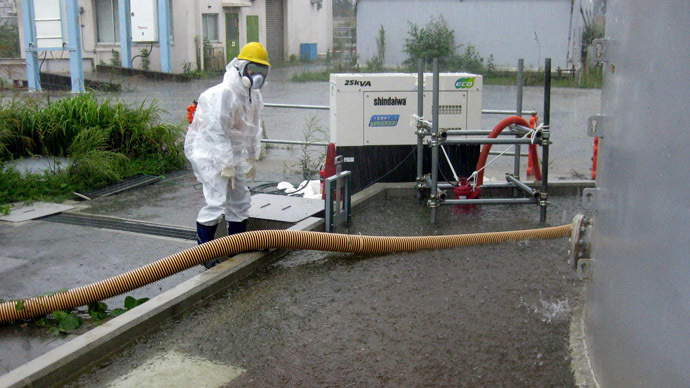Another cooling tank has sprung a leak at Japan’s troubled Fukushima nuclear power plant. As in previous instances, the highly radioactive water is thought to be seeping directly into the Pacific Ocean. This is the second such incident in two months.
Although the Tokyo Electric Power Company (TEPCO) has promised
more accountability following a series of blunders in recent
months, it has become clear to Japan’s government that the plant
operator simply cannot deal with the problem on its own, forcing
them to step in last month and start contributing funds.
The newest leak amounts to about 430 liters of radioactive water
spilling in a period of 12 hours. That water contained 200,000
becquerels per liter of Strontium 90 and other harmful
beta-emitting isotopes. That is tens of thousands of times more
than the legal 30-becquerel limit.
While the plant operator has been pumping hundreds of tons of
water a day over the damaged reactors to cool them in the
aftermath of the 2011 meltdowns, it also relied on makeshift
water tanks above ground to store excessive radioactive water.
But they have been leaking on and off, which led to senior
government spokesman Yoshiide Suga to tell reporters on Thursday
that TEPCO’s efforts at stemming the flow of contaminated water
were insufficient. He added, however, that he believes the
situation to be under control.
Recently it was calculated that the cleanup efforts would batter
the economy and required government funding, as well as at least
four decades, to implement.
It took the electrical power company until July to admit that
water had been leaking into the Pacific, which led to an
international outcry in addition to a national security threat
warning on the part of the United States. Previously, TEPCO had
repeatedly denied that this was a problem.
The incident took place because a worker misjudged the tank’s
water capacity, resulting in the tank tilting to one side, as the
ground underneath it is uneven, TEPCO spokesman Masayuki Ono told
Reuters.
But in that worker’s defense, the company is already being forced
to fill the cooling tanks to the top, as there is simply no
capacity to accommodate all that water, which Ono says is
probably headed down a trench into the Pacific about 300 meters
from the affected tank.
Add to this the problem of accumulating rainwater which also
becomes charged by the nuclear particles.
Although initially water contamination in the surrounding area
was a major scare prompting security alerts as far as the United
States, it has now been determined that the radiation is not an
immediate environmental threat, as the ocean dilutes the
radiation, officials have said.
However, heightened levels of radiation have been detected around
multiple cooling tanks, which points to inherent flaws in their
construction and forecasts increasing complications to be faced
not only during cleanup, but simply to keep the problem of
radioactivity at bay.

